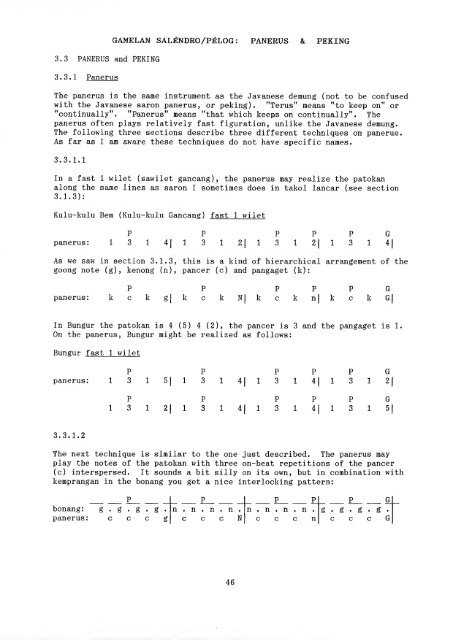Guide to Sundanese Music - Free EBooks Library
Guide to Sundanese Music - Free EBooks Library
Guide to Sundanese Music - Free EBooks Library
Create successful ePaper yourself
Turn your PDF publications into a flip-book with our unique Google optimized e-Paper software.
3.3 PANERUS and PEKING<br />
3.3. 1 Panerus<br />
GAMELAN SALjgNDRO/P^LOG : PANERUS & PEKING<br />
The panerus is the same instrument as the Javanese demung {not <strong>to</strong> be confused<br />
with the Javanese saron panerus, or peking). "Terus" means "<strong>to</strong> keep on" or<br />
"continually". "Panerus" means "that which keeps on continually". The<br />
panerus often plays relatively fast figuration, unlike the Javanese demung.<br />
The following three sections describe three different techniques on panerus.<br />
As far as I am aware these techniques do not have specific names.<br />
3.3.1.1<br />
In a fast 1 wilet (sawilet gancang), the panerus may realize the pa<strong>to</strong>kan<br />
along the same lines as saron I sometimes does in takol lancar (see section<br />
3.1.3):<br />
Kulu-kulu Bern (Kulu-kulu Gancang) fast 1 wilet<br />
panerus:<br />
P P P<br />
3 1 4| 1 3 1 2| 1 3 1 2( 1<br />
P<br />
3<br />
G<br />
1 4|<br />
As we saw in section 3.1.3, this is a kind of hierarchical arrangement of the<br />
goong note (g), kenong (n), pancer (c) and pangaget (k):<br />
panerus: g| k c k N| k<br />
P P P G<br />
c k nl k c k Gi<br />
In Bungur the pa<strong>to</strong>kan is 4 (5) 4 (2), the pancer is 3 and the pangaget is 1.<br />
On the panerus, Bungur might be realized as follows:<br />
Bungur fast 1 wilet<br />
panerus:<br />
3.3.1.2<br />
P<br />
3<br />
P<br />
3 2|<br />
P<br />
3<br />
P<br />
3<br />
The next technique is similar <strong>to</strong> the one just described. The panerus may<br />
play the notes of the pa<strong>to</strong>kan with three on-beat repetitions of the pancer<br />
(c) interspersed. It sounds a bit silly on its own, but in combination with<br />
kemprangan in the bonang you get a nice interlocking pattern:<br />
4|<br />
4|<br />
P<br />
3<br />
P<br />
3<br />
P<br />
4|<br />
P<br />
4|<br />
P<br />
3<br />
P<br />
3<br />
G<br />
2|<br />
G<br />
5i








